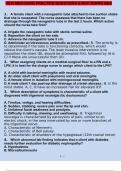MedSurge Hesi
MedSurge Hesi
Page 3 out of 100 results
Sort by
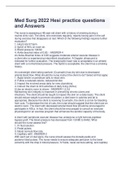
-
Med Surg 2022 Hesi practice questions and Answers
- Exam (elaborations) • 34 pages • 2022
- Available in package deal
-
- $10.49
- + learn more
The nurse is assessing a 48-year-old client with a history of smoking during a routine clinic visit. The client, who exercises regularly, reports having pain in the calf during exercise that disappears at rest. Which of the following findings requires further evaluation? 1. Heart rate 57 bpm. 2. SpO2 of 94% on room air. 3. Blood pressure 134/82. 4. Ankle-brachial index of 0.65. - ANSWER-4 An Ankle-Brachial Index of 0.65 suggests moderate arterial vascular disease in a client who is expe...
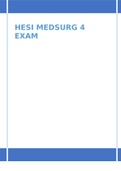
-
HESI MEDSURG 4 EXAM PRACTICE TEST FULL ANSWERS WITH DETAILED EXPLANATION
- Exam (elaborations) • 79 pages • 2022
-
- $17.99
- + learn more
HESI MEDSURG 4 EXAM Quiz1 Question 1 2 / 2 pts A client presents with red, inflamed skin covered with papules, vesicles, and bullae from a type IV hypersensitivity reaction. Which condition/disease will the nurse most likely observe written in the client’s electronic medical record? Allergic rhinitis Correct! Contact dermatitis Goodpasture syndrome Systemic lupus erythematosus (SLE) Question 2 2 / 2 pts A client is admitted to the emergency depa...

-
HESI MEDSURG 1 EXAM REVIEW QUESTIONS AND ANSWERS
- Exam (elaborations) • 119 pages • 2022
-
- $32.49
- + learn more
HESI MEDSURG 1 EXAM REVIEW 1. Nurse in ED caring for a client who is having an acute asthma attack. How can she tell the client in in respiratory distress (Select all) A. 95% O2 B. Wheezing C. Retraction of sternal muscles D. Pink mucous membranes E. Premature ventricular complexes (PVCs) 2. Morning 3. Newly admitted patient w/diagnosis of ascites. What order would the nurse question? (select all) a. High sodium b. Spironolactone c. Paracentesis d. Administration of salt-poor...
MED SURG HESI EXAM BUNDLE QUESTIONS WITH 100% CORRECT ANSWERS GRADED A+
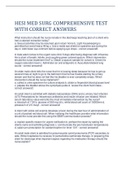
-
HESI MED SURG
- Exam (elaborations) • 18 pages • 2023
-
- $8.49
- + learn more
What instruction should the nurse include in the discharge teaching plan of a client who had a cataract extraction today? a. Sexual activities may be resumed upon return home b. Light housekeeping is permitted but avoid heavy lifting c. Use a metal eye shield on operative eye during the day d. Administer eye ointment before applying eye drops - correct answersB A male adult comes to the urgent care clinic 5 days after being diagnose with influenza. He is short of breath, febrile, and c...
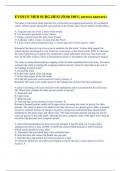
-
EVOLVE MED SURG HESI (With 100% correct answers)
- Exam (elaborations) • 43 pages • 2024
- Available in package deal
-
- $13.49
- + learn more
The nurse is concerned about infection for a client after an esophagogastrostomy for esophageal cancer. Which actions should the nurse include in the client's plan of care? (Select all that apply.) A. Frequent oral care every 2 hours while awake. B. Use incentive spirometer every 2 hours. C. Empty contents from NG tube every 8 hours. D. Ambulate within 1 hour of return from the PACU. E. Limit visitors until postoperative day 2. correct answers Correct Answer: A,B,C Rationale:One hour ...
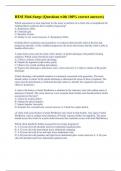
-
HESI Med-Surge (Questions with 100% correct answers)
- Exam (elaborations) • 39 pages • 2024
- Available in package deal
-
- $12.99
- + learn more
Which assessment is most important for the nurse to perform on a client who is hospitalized for Guillain-Barre syndrome that is rapidly progressing? A: Respiratory effort. B: Unsteady gait. C: Intensity of pain. D: Ability to eat. correct answers A: Respiratory Effort (Guillain-Barre syndrome causes paralysis or weakness that typically starts at the feet and progresses upwards. As the condition progresses, the nurse must ensure that the client is able to breathe effectively.) A male cl...
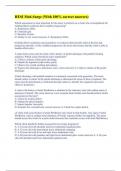
-
HESI Med-Surge (With 100% correct answers)
- Exam (elaborations) • 39 pages • 2024
- Available in package deal
-
- $12.99
- + learn more
Which assessment is most important for the nurse to perform on a client who is hospitalized for Guillain-Barre syndrome that is rapidly progressing? A: Respiratory effort. B: Unsteady gait. C: Intensity of pain. D: Ability to eat. correct answers A: Respiratory Effort (Guillain-Barre syndrome causes paralysis or weakness that typically starts at the feet and progresses upwards. As the condition progresses, the nurse must ensure that the client is able to breathe effectively.) A male cl...
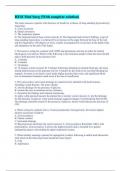
-
HESI Med Surg (With complete solution)
- Exam (elaborations) • 33 pages • 2024
- Available in package deal
-
- $12.99
- + learn more
The nurse assesses a patient with shortness of breath for evidence of long-standing hypoxemia by inspecting: A. Chest excursion B. Spinal curvatures C. The respiratory pattern D. The fingernail and its base correct answers D. The fingernail and its base Clubbing, a sign of long-standing hypoxemia, is evidenced by an increase in the angle between the base of the nail and the fingernail to 180 degrees or more, usually accompanied by an increase in the depth, bulk, and sponginess of the end o...
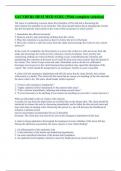
-
SAUNDERS HESI MED SURG (With complete solution)
- Exam (elaborations) • 65 pages • 2024
- Available in package deal
-
- $14.49
- + learn more
The nurse is conducting a session about the principles of first aid and is discussing the interventions for snakebite to an extremity. The nurse should inform those attending the session that the first priority intervention in the event of this occurrence is which action? 1. Immobilize the affected extremity. 2. Remove jewelry and constricting clothing from the victim. 3. Place the extremity in a position so that it is below the level of the heart. 4. Move the victim to a safe area away fr...

Did you know that on average a seller on Stuvia earns $82 per month selling study resources? Hmm, hint, hint. Discover all about earning on Stuvia

